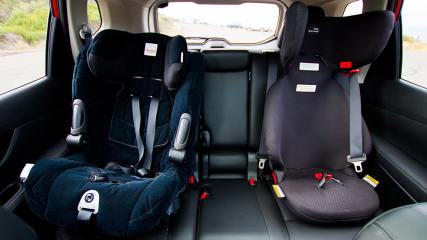Buying a car Interstate: how to purchase a vehicle from another state?
By Stephen Corby · 01 Sep 2020
Australia is a wonderful place, in almost every way, but just sometimes it can be a bit… big. Which is to say that, while a country like England can advertise cars for sale anywhere on its tiny island, and it’s not a huge stretch to travel and look at them in person, buying a car from interstate in this country can mean there’s 4000km between you and the vehicle you want to test drive.And you have to really, really want something to consider buying it when it’s a 40-hour drive away. But such is the global, or at least national market created by the internet - in the old days you only looked at cars for sale in your local paper, so all your options were, effectively, close to home - that if you go shopping for a car on the web, you’re quite likely to be tempted by good-looking machines from many miles away. So, how hard is it to buy a car from interstate? Would you do it, could you do it, should you do it? Well, the fact is that Australians, all across this vast country, are doing it every day. So be not afraid, and just read our handy guide below on how to buy a car interstate, the pros and cons and the pitfalls to watch out for. Absolutely you can, yes, and the reason you might want to is that being willing to do so increases the number of cars you can look at and might therefore secure you a better price. Just be sure to consider the extra costs that might be involved in transporting the car to your home state when working out the size of that discount. In some cases, cars might also just be a bit cheaper in other states, so it’s definitely worth at least having a look. You can buy from an interstate dealer, although it’s worth checking - even if you’ve found a particularly great price - whether your local dealer can match it, particularly if you’re buying a new car. It seems unlikely you’d be able to get a new car from a dealer interstate that’s so much cheaper than your local dealers that it would make up the costs of shipping etc. Although a motivated dealer interstate might be motivated to ship the car to you.It’s more likely that you might find the particular second-hand car of your dreams at a dealer interstate, with just the right spec, colour or mileage. The good news is, particularly if you’re not going to be physically able to go and check the car out in person because of the distance, that any car bought interstate from a dealer should be protected by a warranty.Used-car dealers are required by law to provide a three-month/5000km warranty as long as the car you’re buying has less than 160,000km on the odometer and is less than 10 years old. With online auctions increasingly common this is a way a lot of people are now buying cars, and the good news is that the same second-hand-warranty laws apply to any vehicle bought from a licensed auctioneer. If you buy from an auction and the car does not come with a warranty, the auctioneer must inform you of that, at which point you can either walk away from the deal, or sign up for the fact that you’ll be stuck with any costs from any defects you’ve been unable to spot because you weren’t ever in the room with the vehicle. Yes, if you’re in the ACT and looking at a car in NSW, you might just want to drive there and get your hands on it, and your bum in it, but if the distance involved is just too great, you’re going to want, indeed need, to pay someone else to have a look at it for you.Once you’ve done all the obvious online checks into the vehicle you’re looking at - making sure it’s not stolen, or encumbered with debt, all of which you can do through the Personal Property Securities Register - you’ll want to take advantage of pre-purchase vehicle inspection service in the state where the car is for sale. These services are available from all teh major motoring organisations, and there’s one in each state - like the NRMA, the RACV in Victoria, RACQ in Queensland and so forth. Do not be tempted to forgo the cost of one of these inspections - usually between $250 and $300 - and buy a vehicle sight unseen. The risk is too high, and the saving versus potential loss equation makes no sense. Obviously, the cost of freighting your new car back to your home state is going to vary enormously, based on where you’ve bought it - Perth to Cairns, for example, is going to be an expensive proposition.That’s why you’ll want to consider that cost when making your choice, and get a quote on transport fees before you buy. Be sure to get more than one quote from more than one company before making a choice as prices can vary, but the costs can be as low as $250 but can be as high as $1500, depending on the size of the vehicle and the distance travelled. When you buy a new car you have to sort the insurance and the change of registration into your name, and buying a car from interstate simply adds a little complexity to that process, and possibly a little bit of cost as well.Australia does not like to have consistent laws and rules for such things between states so you’ll need to check what applies to the state you’re buying from and bringing the car into.You’ll need to transfer the registration from the state of origin, where the vendor is, to your home state, and if you’re intending to drive the car from one state to another, you’ll also have to secure a form of temporary registration, typically called an Unregistered Vehicle Permit, which you can apply for at your state authority. This form will mean you have CTP insurance while transporting the vehicle. If you’re moving the vehicle by freight, of course, and thus keeping the unnecessary kilometres off the clock, you don’t need to worry about this. The NSW RMS site has some helpful advice about the issuing of new plates, and whether you can keep the old ones here.When you register an interstate vehicle in NSW, Roads and Maritime assigns NSW plates, and records that the interstate plates are no longer associated with the vehicle. This information is also sent to the interstate authority.You’ll be issued with a receipt, which you may be able to take to the interstate authority in order to receive a registration refund. Contact the interstate authority for specific information.Some states and territories allow you to keep number plates when they are no longer associated with a vehicle:Queensland: You may keep all special, personalised, custom and prestige platesSouth Australia: You may keep some special plates, Grand Prix, Jubilee and Numeral-only platesVictoria: All plates may be keptTasmania: All personalised plates may be kept.Western Australia, the Northern Territory and the Australian Capital Territory do not allow you to keep plates.If your vehicle is from one of these jurisdictions, you’ll need to hand in the existing plates at the registry or Service NSW centre when you apply for NSW registration.The details for what to do in WA are here.In South Australia, Stamp Duty is also a factor, as explained here.And here: If you do not have an interstate registration certificate the vehicle must have a vehicle inspection to confirm the correct identity of the vehicle, and stamp duty will be payable as well as the applicable registration fees.In Victoria, the trickiness level is raised because you need an appointment, the process is all explained here.Handing in your interstate plates is compulsory in Qld, as explained here. If you’re the seller, you want to cast your net as far and wide as possible, so being wiling to accept offers from interstate is a good idea. Just be aware that you’re going to get a lot of questions from someone who’s worried they can’t eyeball the car themselves, and be accommodating when they want to send someone around to do a pre-inspection on your car.







.jpg)
.jpg)







.jpg.jpg)